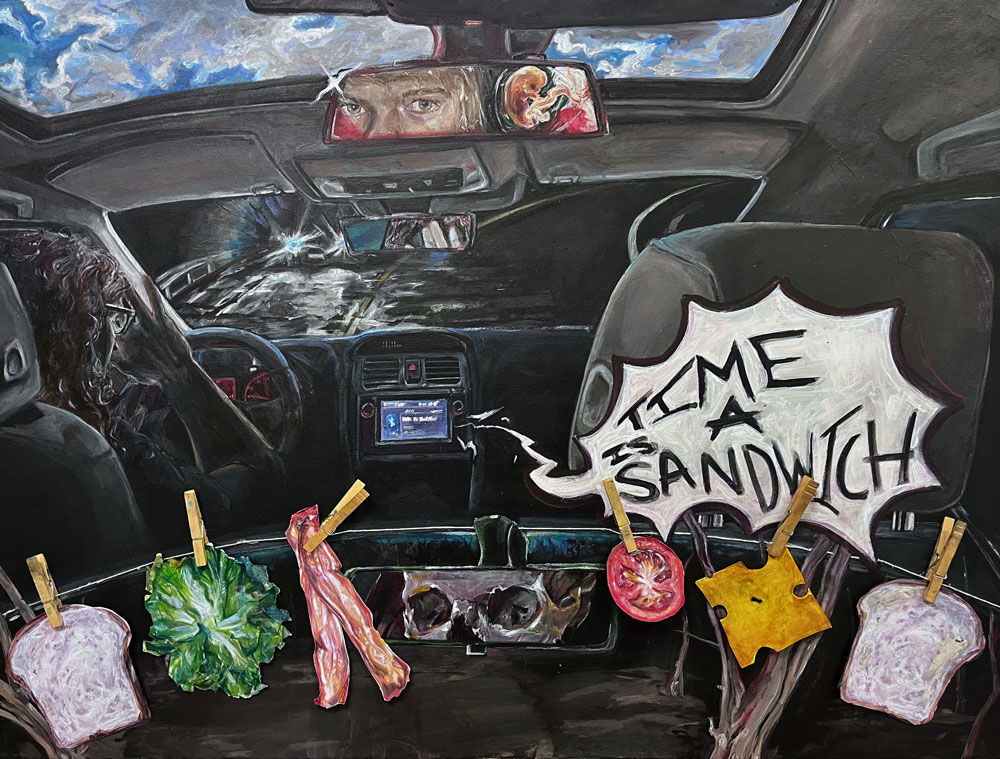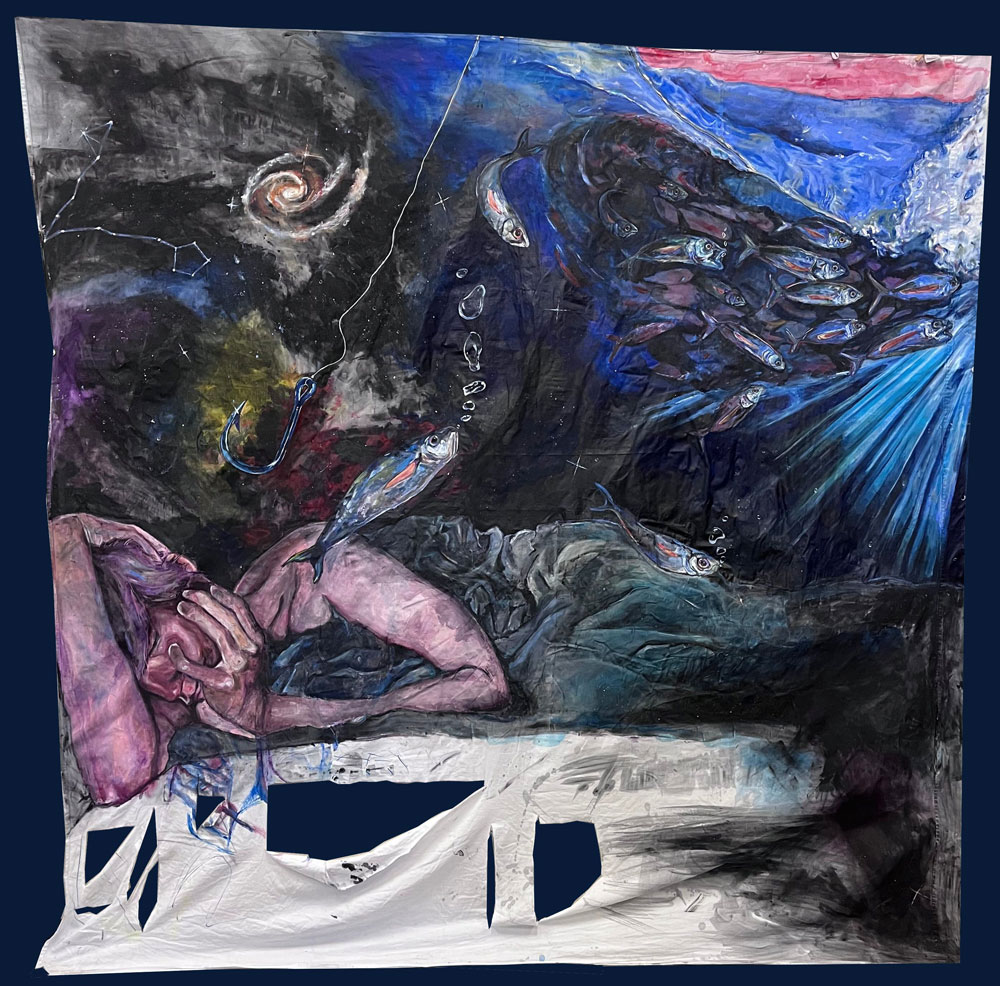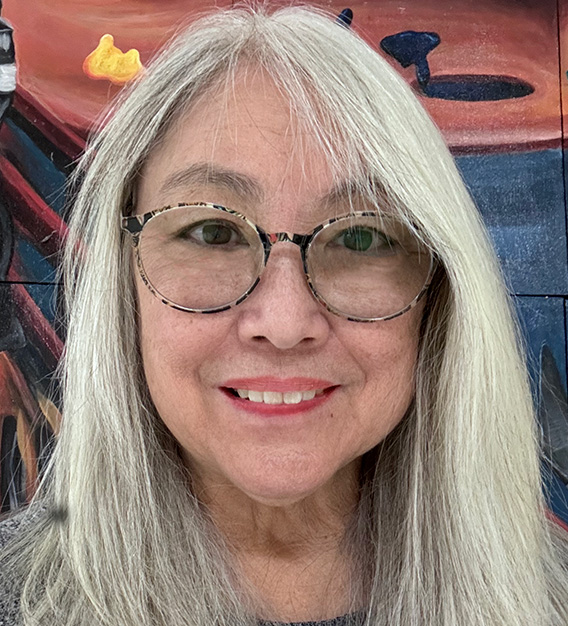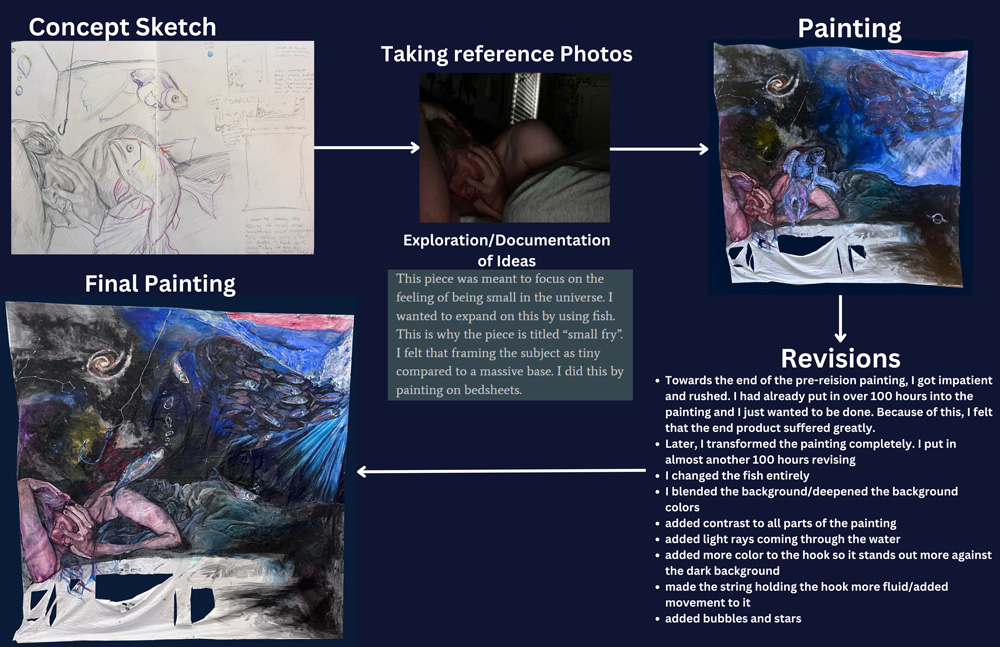


Time is a Sandwich
Height: 30" x Width: 40" x Depth: 1" | Material(s): Acrylic paint, canvas, string, 6 wood clips, hot glue | Process(es): Sketched+painted canvas; sewed thread in canvas; painted, cut out, and clipped sandwich ingredients | Citation(s): Personal pictures, internet (combined references and lighting of skulls and ingredients) | Idea(s): Time is layered like a sandwich (everything at once). Life and death is bread. Experience is the meat. | Curatorial Note: The energetic use of expressive brush work combined with the subject matter creates a sense of urgency of life.
Ethan David
Student statement
Student statement
In what ways did you practice and experiment when developing your sustained investigation?
I made concept sketches for all of my works. If I was unexperienced with a specific media or ground, I experimented with it until I felt I understood the media enough to begin creating art with it. When an idea would come to me, I would write it down in my sketchbook and think of ways I could expand upon it.
How did you demonstrate revision in your sustained investigation?
After finishing later paintings, I would come back to old ones to fix up or even restart the works entirely. Because you make improvements in art the more you do, looking back on my older work made me want to change them into the best version they could be. Because of this, I would feel guilty knowing that I could express my ideas in a more appealing or more accurate manner. This mindset was demonstrated exactly within both "Time is a Sandwich" and "Small Fry." I put over 100 hours of revisions into "Small Fry." I did this not only because of its size but also because of the rushed manner in which I felt I employed my ideas within the original. I practically redid the entire painting by adding light rays, reimagining the school of fish completely, adding emphasis on the figure at the bottom, and finding a good balance between every idea I wanted to employ on the massive base I was conducting the painting. In the original "Time is a Sandwich," there was no timeline at all, which is ironic considering how it became one of the focal ideas the finished work relies upon. It was only because of the hours of revisions I put into the painting that I feel I was able to fully convey the thought process I had in mind to the viewer. While not always the most entertaining, revisions were a vital process within my sustained investigation.

My work became more focused on the value of life rather than observing people as statistics.
How did your materials and process(es) choices shape the creation or meaning of your artwork(s)?
On "Time is a Sandwich" I wanted to create a sort of timeline that reflected a "string" of events. I sewed string into the canvas and, in my sketchbook, experimented with ways I could go about uniquely conveying this concept. I then thought of ways to connect the idea to the sandwich metaphor I had established at the base of the painting. I finally, with these different ideas, decided to use different sandwich ingredients to convey different points of human life on the timeline. The slices of bread represented life and death while the ingredients between were a stand-in for human experiences. I created the ingredients using acrylic paint on cardstock, cut them out, and clipped them onto the timeline using clothing pins. By using a different material to paint on than I did the main painting, the sandwich ingredients popped out more, which enhanced its purpose within the painting both visually and metaphorically.
On "Small Fry" I wanted to use a massive base to convey the idea of feeling small in the universe. When I struggled with this concept, I often found myself lying in bed contemplating the point of existence as a whole. Because of this, I figured that bedsheets would be a perfect choice for the massive base I could paint on as it fit the criteria and related to my own personal struggle with the subject.

Small Fry

Material(s): Acrylic paint, bed sheet | Process(es): Planned, sketched and painted on sheet, revised | Citation(s): Personal pics, internet (combined different types of fish I found and used references for space) | Idea(s): No one's special/can escape death. People are a statistic in this thought. Makes people feel small.
How did your art teacher support your artistic development?
Mrs. Goodman let me stay late in her class nearly every day to help me make progress on my paintings. She would critique my work when I asked and helped me get my work up to its best possible quality.
What is your advice to other AP Art and Design students?
Don't just view your art projects as a grade for the class. Try expressing concepts and emotions in your work. When you care about what you're creating, it becomes so much easier, and the finished product benefits greatly. The viewer can tell if there was genuine passion put into the work. Always put your best abilities into what you're creating.

Helen Goodman
Art Instructor
Cabot High School, Cabot, AR, USA
Teacher statement
Teacher statement
What are you most proud of regarding your school’s AP Art and Design program, student, and teacher?
Our administration and supervisors are extremely supportive of our AP Art and Design Program. Our class is yearlong and double blocked in a seven-period day to provide students the sustained class time that yields larger spans of art-focused time. I am very proud of the scores our students have consistently made and the level of talent, work ethic, and creative exploration they bring to the game. Ethan David certainly embodies all of these. It's rare to see his level of dedication and tireless pursuit of excellence. I am pleased to have him again this year in AP Art and Design 2D where he continues to be an inspiration. It's students like him that keep this work exciting!
What do you do to support visual arts programming in your school?
We work to maintain arts visibility through school and community involvement that includes volunteer work with elementary schools as well as social media posts about our department's activities. In the main hallway of our building, we sponsor an art display that rotates periodically. We have participated in community activities that include window painting, mural design, and painting as well a logo design work when commissioned.
We have an annual art show involving all art students each spring. AP Art and Design students display up to eight works accompanied by an artist's statement that overviews their sustained investigation question and the progression of their work in pursuit of that question.
What is your advice to other school leaders on how to support an AP Art and Design program?
Give your AP Art and Design teachers and students support by providing the time, space, and materials to sustain them in their pursuit of a meaningful portfolio experience. Foundational art classes should prepare students with the knowledge, skills, and concepts that will aid them in the rigors of AP Art and Design. Additionally, it's important to understand and appreciate the value of the arts in developing the growth,development and passions of our students.

Material(s): Acrylic Paint, Bed Sheet | Process(es): Planned, Sketched and painted on sheet, revised | Citation(s): Personal Pics, Internet (Combined different types of fish I found and used references for space) | Idea(s): No one's special/can escape death. People are a statistic in this thought. Makes people feel small.

Michael Falcinelli
Cabot High School, Cabot, AR, USA
Principal
Leader Statement
Leader Statement
What are you most proud of regarding your school’s AP Art and Design program, student, and teacher?
To state how proud I am of our AP Art and Design Program would be a major understatement. By just walking through the classroom and looking at the students’ works displayed and how impressive each piece is is truly an honor that I can do each day. As a proud school leader, it is an honor to introduce this remarkable exhibit, which showcases the exceptional artistic talents of one of our students, Ethan David, and highlights the invaluable guidance of our dedicated art teacher, Ms. Helen Goodman. Much of the credit belongs to the exceptional instruction provided by Ms. Goodman. Her ability to inspire and nurture our students' talents has been instrumental in fostering a classroom environment where creativity flourishes. Through innovative lessons, constructive feedback, and unwavering support, Ms. Goodman has equipped students with the skills and confidence needed to bring their artistic visions to life. This exhibit reflects the creativity, hard work, and growth of Ethan. Each piece tells a unique story, embodying not only technical skill but also the exploration of ideas, emotions, and self-expression. The depth of these artworks reminds us of the boundless potential that Ethan has when given the tools and encouragement to thrive.
What do you do to support visual arts programming in your school?
At Cabot High School, we take immense pride in fostering a thriving visual arts program that empowers students to explore their creativity, develop technical skills, and express themselves. Our commitment to the arts is reflected in several key initiatives and resources designed to support our young artists. We are fortunate to have a team of highly skilled art teachers who are not only experts in their fields but also deeply committed to mentoring and inspiring our students. We encourage students to participate in regional and national art competitions, celebrating their achievements and helping them gain recognition for their talent. Some of these works are also displayed throughout Cabot High School. Our Art Club offers students additional opportunities to collaborate, work on special projects, and contribute to campus beautification through murals and installations. For me personally, it is very rewarding seeing the lifelong relationships that are developed between teachers and students. At Cabot High School, we promote and encourage these positive relationships. Our students know that they are valued and cared for.
What is your advice to other school leaders on how to support an AP Art and Design program?
The success of any AP Art and Design program begins with a passionate and knowledgeable teacher. Support their professional development by funding attendance at AP workshops, conferences, and continuing education opportunities. Encourage collaboration with other departments and community artists to expand creative ideas. Promote the program to students and parents, emphasizing the value of AP Art and Design in developing critical thinking, creative problem-solving, and discipline. Show how it aligns with college and career readiness, especially for students pursuing the arts. As the school leader, it is important to recognize the students and their works. Showcase your students’ talents with public exhibitions, online galleries, and features in school publications. Recognition fosters pride and motivates students to push their creative boundaries.

Ethan David





